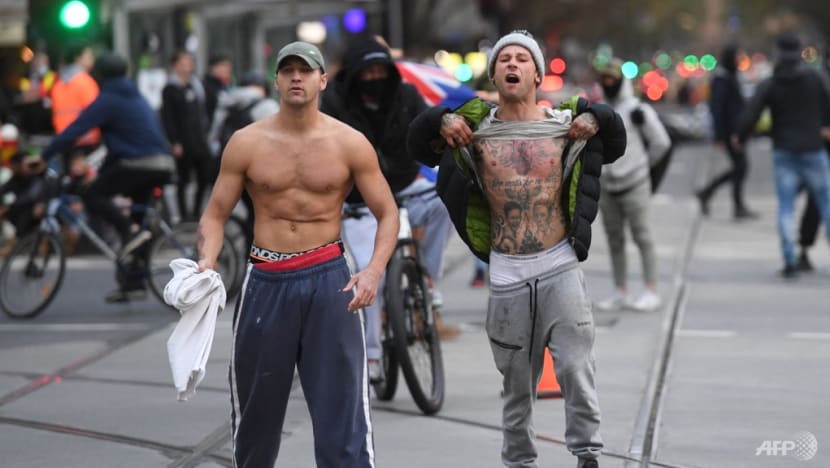Commentary: Things in Australia could have turned out differently with an aggressive vaccine strategy
Violent protests by construction workers this week have shone a spotlight on Australia’s deeper problems and lack of focus on vaccination at the pandemic’s outset, says Mike Yeo.

Officers used pepper spray and made over 200 arrests in Melbourne as several hundred attendees flouted stay-at-home orders and marched through an inner-city suburb. (Photo: AFP)
MELBOURNE: Living in Australia can feel like an endless repetition of what just happened a month ago.
COVID-related demonstrations involving hundreds of maskless protesters broke out in Sydney in end-July. More rippled through key cities Melbourne and Brisbane in end-August.
And just this past week, wild scenes of violent clashes with police officers in Melbourne flooded social media.
These never-ending waves of crowds getting into brawls with authorities have brought into sharper focus how extended lockdowns in the country have left a lot of people furious and exhausted from going around in pandemic circles with no end in sight.
PROTESTING A VACCINE MANDATE
While past demonstrations were set off by frustration against new lockdowns, the flashpoint this week was the Victorian state government’s new vaccine mandate for the construction industry.
In theory, the move would have benefitted construction firms and workers, by allowing the sector to continue operations despite Melbourne’s lockdown, pending a COVID-safe plan to be worked out among government officials, the industry and unions.
Instead, it earned backlash. Repeated violations of COVID-safe rules in recent months have seen authorities place the industry on notice, with a tightening set of restrictions hiking tensions.
Rumblings of discontent at the closure of worksite break rooms in a bid to contain outbreaks culminated in scuffles outside the construction industry union’s offices in Melbourne on Monday. It had just agreed to rules requiring workers to get at least one dose of the vaccine by this week before returning to work.

Order should have been restored when the state government called for a two-week closure of construction sites the following day. This should have calmed fraying nerves and given time for cool heads to weigh the trade-offs. Instead, havoc erupted as more marched through Melbourne.
The dramatic coverage and viral videos may have exaggerated the extent to which unhappiness is shared by the broader population. Demonstrations involving at most 2,000 protesters barely represent Victoria’s construction sector of 300,000 workers.
But the worry is that COVID-19 issues could provide fodder for opportunistic fringe elements like anti-vaxxers, anti-lockdown agitators and far right neo-Nazis to stoke the flames and stir up more trouble.
Unions have warned about such influences for months. While observers have assessed that the vast majority of this week’s protesters remained construction workers, with little evidence other parties had a hand in organising demonstrations, they point to such groups using social media channels like Telegram to sow mayhem on Melbourne’s streets.
They have been responsible for the harassment of mobile vaccination centres, attacks on at least one clinic providing services to the destitute and homeless, and incidences of healthcare workers being spat at in recent weeks.
LOCKDOWN FATIGUE
The rest of Melbourne, hoping for curbs on workplaces and school closures to lift, are aghast at the protests and the broader prospects of a deteriorating situation.
People are exhausted with lockdown fatigue. The state capital of Victoria has been in lockdown on six occasions lasting more than 200 days and counting since the first in March 2020. The current lockdown has just passed its 50-day mark.
Insanely strict rules - closures of outdoor playgrounds, curfews and curbs on travelling beyond 5km from home – were eased last week but there’s no guarantee they won’t return.
Authorities have issued warnings following high-profile violations – like that 70-strong engagement party in late-August which included healthcare workers subsequently fined over A$5,400 (US$3,900) each.
The Delta variant also continues to tear through construction sites, the young, unvaccinated people, and essential workers are groups identified as key clusters in Melbourne’s recent spread.
The restrictions are exacting a massive mental toll. Psychologists across Australia are so stretched, many are turning new clients away and working into the night to deal with ballooning wait lists.
RENEWED FOCUS ON VACCINATION
The good news is many state governments have jettisoned the unrealistic Australia-wide aspiration of zero COVID-19 cases and are directing efforts towards vaccinating their way out of lockdowns.
“There is not one corner of metropolitan Melbourne not touched by this virus," acting Victorian chief health officer Ben Cowie acknowledged this month.
Roadmaps to opening up have been released, pegged to aims of getting 70 per cent of the adult population fully vaccinated in late October and 80 per cent by Christmas.
But with infection rates still high – Sydney is in excess of 1,000 cases a day with Melbourne at more than 700 daily - hospitals have come under strain.
SECURING VACCINES TOO LATE
The elephant in the room is vaccine availability. Australia still needs to husband existing stocks and is continuing to seek more supplies from abroad.
The country has proudly announced that about 74 per cent of its over-16s have taken one dose, with 49.3 per cent of the same demographic double dosed as of Sep 23 but this still leaves Australia in 35th place out of 38 OECD countries.
A litany of early missteps in the acquisition of vaccines by the Australian government in 2020 means its vaccination programme is still behind the curve.
Prime Minister Scott Morrison’s government had bet on the AstraZeneca vaccine, setting up a production facility in Melbourne to manufacture 50 million doses onshore and importing another 3.8 million doses.
Yet fears over extremely rare but potentially fatal blood clots led health authorities to recommend the vaccine only for Australian seniors.
Political leaders and healthcare officials could have done more to counter disinformation and sensational coverage about these side effects, a failure former deputy Chief Medical Officer Dr Nick Coatsworth publicly acknowledged in August.
Worse still, others fuelled hesitancy. Queensland chief health officer Dr Jeanette Young even went against the official recommendation for those aged 18 to 59 to choose whether to get vaccinated with the AstraZeneca. She advocated against young Australians getting the AstraZeneca vaccine altogether.
This leaves Pfizer-BioNTech’s mRNA vaccine as the preferred choice for the vast majority of Australians, despite more than adequate supplies of AstraZeneca vaccine successfully deployed in places like the United Kingdom.
But the trouble is Australia only ordered 10 million Pfizer-BioNTech doses for 2021 in November 2020, grossly insufficient for its 26 million-strong population. This was despite the pharmaceutical giant reaching out in June 2020 urging to discuss a vaccine deal as countries like the US and UK nailed down early orders.
Australia belatedly added a further 10 million in February for this year. Another 20 million doses were ordered in April but will only arrive in 2022 and 2023.
The already delayed vaccine rollout could be dealt a further blow with revelations on Thursday that Australia’s supply of Pfizer vaccines may face further delays due to potential supply issues.
Australia had spread its vaccine bets on a few options. However, a University of Queensland vaccine development effort failed early trials and Moderna doses have only started arriving in Australia.
Other nations have chipped in, with Poland, Singapore and the United Kingdom sending spare Pfizer doses. Even then, Australian states have little assurance of sufficient vaccines going forward, after being told by the federal government total available doses will slip from almost 11 million in September to 8.4 million in October.
Why do some scientists disagree whether COVID-19 booster shots are needed beyond seniors and those with weaker immune systems? Experts explain what a third shot offers in this week’s Heart of the Matter podcast:
VACCINATION COULD HAVE KEPT AUSTRALIA OPEN
The fallout from these blunders is still being felt throughout the country today, with lockdowns hurting already struggling small businesses in cities and small towns.
There’s little doubt the Delta outbreak has hammered home in Australia the idea that vaccination is the only realistic way of breaking out of this cycle, and Australians have shown a renewed enthusiasm for getting their dose, in the face of surging infections.
But scenes like those protests by construction workers will likely continue. A Melbourne Institute survey shows high vaccine scepticism among Victoria’s construction workers, with more than a third unlikely or outrightly refusing the shot.
It’s hard to pinpoint with razor-sharp accuracy how much of a difference higher vaccination rates could have made to Australia’s situation.
But with this much resistance to vaccine mandates and lockdowns, the answer is probably a lot.
Mike Yeo writes from Melbourne. He is the Asia reporter for US-based defence publication Defense News.


















